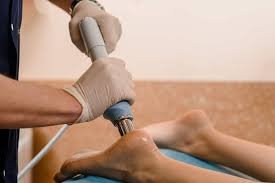What is Shockwave Therapy?
Shockwave therapy is a non-invasive treatment that uses high-energy sound waves to relieve pain and promote healing. It’s been gaining popularity for its effectiveness in treating a variety of musculoskeletal conditions.
How Does Shockwave Therapy Work?
-
Pain relief: Shockwaves disrupt pain pathways and stimulate the release of pain-relieving substances in the body.
-
Tissue repair: They promote blood flow and collagen production, which aids in tissue repair and regeneration.
-
Inflammation reduction: Shockwaves can help reduce inflammation in the affected area.
Conditions Treated with Shockwave Therapy
Shockwave therapy has shown promising results in treating a wide range of conditions, including:
Tendinopathies
-
Plantar fasciitis: Heel pain caused by inflammation of the plantar fascia.
-
Achilles tendinopathy: Pain and stiffness in the Achilles tendon.
-
Tennis elbow (lateral epicondylitis): Pain on the outside of the elbow.
-
Golfer’s elbow (medial epicondylitis): Pain on the inside of the elbow.
-
Rotator cuff tendinopathy: Shoulder pain caused by inflammation of the rotator cuff tendons.
-
Patellar tendinopathy (jumper’s knee): Knee pain in athletes.
Other Conditions
-
Osteoarthritis: Joint pain and stiffness.
-
Bursitis: Inflammation of the bursae, fluid-filled sacs that cushion joints.
-
Shin splints: Pain along the shinbone.
-
Non-healing fractures: Slow-healing bone fractures.
Is Shockwave Therapy Right for You?
Shockwave therapy is generally considered safe and effective, but it’s essential to consult with a healthcare professional to determine if it’s the right treatment for your condition. They can assess your specific needs and recommend the best course of action.
Important Considerations
-
Shockwave therapy is not a magic cure and may require multiple sessions for optimal results.
-
It’s often combined with other treatments, such as physical therapy and stretching, for maximum benefit.
-
There may be some discomfort during the treatment, but it is usually tolerable.
If you’re experiencing persistent pain or discomfort, it’s worth considering shockwave therapy as a potential treatment option. Consult with a qualified healthcare provider to learn more about the benefits and risks.
For more information about shockwave therapy, have a look at this article by Mayo Clinic https://www.mayoclinic.org/medical-professionals/physical-medicine-rehabilitation/news/the-evolving-use-of-extracorporeal-shock-wave-therapy-in-managing-musculoskeletal-and-neurological-diagnoses/mac-20527246




